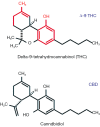Cannabinoids for pediatric epilepsy? Up in smoke or real science?
- PMID: 26835389
- PMCID: PMC4729003
- DOI: 10.3978/j.issn.2224-4336.2015.10.03
Cannabinoids for pediatric epilepsy? Up in smoke or real science?
Abstract
Public interest in the use of "medical marijuana" for the treatment of childhood epilepsy has burgeoned in the last few years. This has occurred in parallel with a growing interest in "medical marijuana" in general. Physicians and pediatricians must balance their patients' desire for immediate access to these products with the tenets of evidence-based medicine. This review discusses the biochemistry of cannabis products (the phytocannabinoids) setting this in the context of the endogenous endocannabinoid system. The differing and potentially modulating effects of delta-9-tetrahydrocannabinol (THC) and cannabidiol (CBD) are reviewed. The evidence-base supporting or not the use of cannabis products for the treatment of neurological disease and specifically epilepsy is explored. The potential for adverse effects and particularly of neurotoxicity is addressed. Finally, public health and sociocultural implications are touched upon. Specific recommendations for interested physicians are provided including advocacy for patients and for a change in the "scheduling" of cannabis in order to better foster much-needed high-quality scientific research in this important area.
Keywords: Cannabidiol (CBD); cannabis; epilepsy; medical marijuana; tetrahydrocannabinol (THC).
Conflict of interest statement
Figures




References
-
- Gupta S. Why I changed my mind on weed. 2013. Available online: http://www.cnn.com/2013/08/08/health/gupta-changed-mind-marijuana/
-
- Maa E, Figi P. The case for medical marijuana in epilepsy. Epilepsia 2014;55:783-6. - PubMed
-
- Bloom S. CBD Oil Now Legal in 15 States. 2015. Available online: http://www.celebstoner.com/news/marijuana-news/2014/03/13/four-states-on...
Publication types
LinkOut - more resources
Full Text Sources
